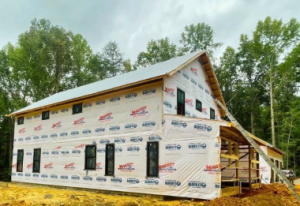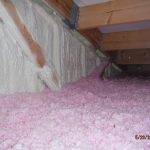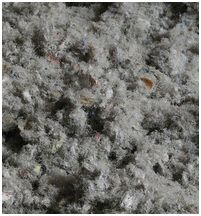As my long time readers know, I am a proponent of having a high quality housewrap between framing (or sheathing) and siding for any pole building which will be climate controlled.
 I also try to keep abreast of new products and innovations. Here is one which sounds good, but may not deliver.
I also try to keep abreast of new products and innovations. Here is one which sounds good, but may not deliver.
After two years of research and development, DuPont announced the launch of what it calls an industry first: insulating housewrap.
“This is arguably the most important introduction in our product group in a long time,” says Jim Ash, new business development manager for DuPont. “It’s taking us into the insulation business, which is a big strategic push for us, and hopefully the first of many.”
In its construction, Tyvek Thermawrap R5.0 comprises the maker’s long-standing Tyvek housewrap bonded to an insulation blanket. The combination has allowed DuPont to enter into the continuous insulation category – an area which is getting increased attention thanks to requirements by the 2012 International Energy Conservation Code which went into effect October 18, 2013. Up to now, the category comprised mainly rigid foam panels for exterior insulation. Thermawrap R5.0 provides builders with another alternative to insulating pole buildings from the outside. The goal is to offer a net effective R-value of R-5.
It may seem counterintuitive to put padded insulation in a situation where contact with moisture is almost a certainty. Ash says not to worry.
“We all know it’s not a question of if, but when, walls will get wet,” says Ash. “Thermawrap R5.0 is as permeable as housewrap, which hits on the product’s No. 1 value proposition: it can dry from the inside or the outside. It breathes moisture vapor.”
DuPont says the Tyvek on the outside of the blanket works just as it would if it was installed on its own by keeping air and bulk water out of walls, but also serving as a breathable barrier allowing moisture vapor to escape to the outside. In addition, in cases where wall sheathing (typically plywood or OSB – oriented strand board) DuPont says the blanket increases the temperature of the sheathing, which decreases the chance for interstitial wall condensation in heating climates. “This reduces the likelihood of getting moisture vapor inside the walls,” Ash says.
For installation, Thermawrap 5.0 doesn’t require any unusual materials. Designed to be installed like housewrap with cap staples or cap nails (DuPont recommends its minimum 3/4-inch Tyvek brand fasteners), the rolls feature an uninsulated flap along the bottom edge which overlaps the course below to further prevent moisture penetration. Cutting the material, however is slightly different. Ash says shears, rotary cutters, or even a carpet knife work well for cutting and trimming Thermawrap R5.0.
Worried about compressing the material beneath siding? Thermawrap R5.0 measures 1.5 inches thick and DuPont says it will introduce Insulated Battens in mid-2014 to provide a stable base for the installation of fiber cement, wood lap siding, manufactured stone veneer, and stucco. The battens, however, are not needed behind vinyl siding, brick, or stone. This author’s take is – I am not seeing how it is the listed installation would not crush the insulation. Installers will, however, want to use 2×4 wood buck bump-outs around windows and doors so the openings are on the same plane as the blanket material.
Thermawrap R5.0’s benefits will come at a premium. DuPont says the total installed cost (including materials and labor) will run 15% to 20% higher than the total installed cost of a premium housewrap plus 1-inch exterior rigid foam insulation. The company expects Thermawrap R5.0’s thermal benefits, along with Class A fire rating and other benefits as mentioned will make the new material an attractive proposition to the industry.
The insulation blanket is made of proprietary fibers, including 20% pre-consumer recycled Tyvek. The product is available in 4-by-40-foot rolls. Each roll weighs approximately 26 pounds and Ash estimates about 20 rolls would outfit the average home.
Here is the rub when it comes to typical post frame construction, if being applied over wall girts and beneath steel siding, the insulation is going to be crushed down to nothing (basically R-0) every time it crosses a framing member.
In my humble opinion, to get the most bang for the buck, go with a thicker wall cavity to provide for thicker wall insulation, then use a traditional housewrap.








